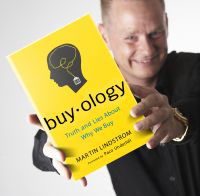
One of the things I talk about is the innate irrationality of humans when it comes to making decisions, and how subjective we all are to our emotions – conscious or otherwise. Many conventional businesses and business practices often cling desperately to the opposite.
Martin Lindstrom’s book Buyology effectively uses the latest brain imaging techniques to confirm this. As consumers, we are driven by our feelings, emotions, preconceptions, habits, rituals and other core human traits. “…roughly 90% of our consumer buying behaviour is unconscious.”
Some interesting revelations:
- Nasty images on cigarette packs actually trigger the desire to smoke.
- Scary images used in anti-anorexia advertising actually increases the likelihood of someone wanting to become anorexic.
- We are often in denial about what we truly feel. We say what we think we should say, or what we think the marketing researchers want to hear.
- We have “increasingly finite and word out attention spans”. We are good at filtering out noise. And most advertising is noise.
- Product placements only work when they are integrated into the storytelling. Otherwise they are seen as advertising.
- Advertising only works when it is not recognised as advertising (ie subliminal).
- Sponsoring shows, even highly successful shows, is a waste of money. The sponsors’ products and services must be part and parcel of the story.
- Logos in and of themselves are not as useful as when it is combined with sounds and smells. Martin calls this “Sensory Branding”.
- More of us prefer the instant gratification of receiving $15 now, over being posted $20 at some later stage.
- “We are sensitive to positive social signals”. You can charge more for something if you smile at people more.
- People reacted positively to the “adorable face” of the Mini.
- Our mirror neurons enable us to feel the same thing as the person we are watching.
- We are highly subject to rituals. If you have a ritual associated with your product or service, you have stickiness.
- We are susceptible to these ten common pillars of religion: sense of belonging, clear vision, power over enemies, sensory appeal, storytelling, grandeur, evangelism, symbols, mystery, and rituals.
- If you can create a somatic marker in your customers’ minds, you will equip them to choose your product unconsciously.
- “Sex does not sell anything other than itself”. The sex overshadows the message and brand.
- Celebrities and “preternaturally beautiful” people overshadows the message and brand. They add a sense of unauthenticity to the message.
- We have “a desire for authenticity.” “Consumers enjoy watching and empathizing with people like themselves.”
The book presented a lot of (what appears to be solid) current research findings in an easy-to-read format. If you enjoy spending time with an expert listening to him tell you interesting and entertaining stories – stories that are nonetheless based on research, experience and facts – you will enjoy reading this book.
“A lot of what happens in the brain is emotional, not cognitive” George Lowenstein, behavioural economist, Carnegie Mellon University.
The research findings are in. It is time to get those soft-skills and processes implemented not just in marketing but throughout your organisation.
Disclaimer: Martin sent me a copy of his book and asked me to write about it. Yes, I did enjoy reading this book – which I did from cover to cover in about 12 hours. No, I was not paid to write this.